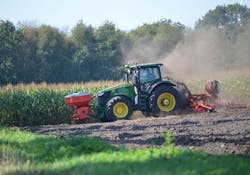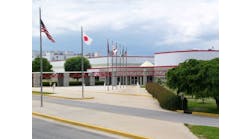The North American ag tire market is up significantly this year versus last year. But shipping complications, the lingering effects of COVID-19 and other issues continue to cast a shadow as 2021 draws to a close.
What can we expect to see in 2022? Representatives from a number of ag tire manufacturers and suppliers share their thoughts below.
MTD: Can you describe the state of the North American ag tire market? Is it up, down or flat versus last year?
Dana Berger, ag business development manager, Continental Tire the Americas LLC: The North American ag market is definitely up over last year. The pandemic may have slowed some businesses and halted otters, but for those running farm equipment, their business was essential. Equipment was in regular use and tires still needed to be replaced.
Bill Dashiell, senior vice president, commercial tire division, TBC Brands: The overall North American ag tire market is up versus last year. The ag sector has remained strong, minus weather-related issues in certain areas, such as California, due to drought. Throughout the tire industry, COVID-19-related challenges continue to affect supply, resulting in high demand for in-stock tires. While we are no exception, our Harvest King program has experienced extreme growth.
Greg Gilland, vice president, global agriculture, Maxam Tire North America: The ag tire market is up significantly compared to last year. The primary factors for this incredible leap in demand are based on core crop prices for 2021. Despite the economic impact of the COVID-19 pandemic, we have experienced almost a doubling of crop prices in less than 15 months, beginning in the second half of 2020. This explosion of demand is primarily centered on global demand for wheat, soybeans, corn and cotton. Improved profits for farmers and growers because of crop prices have fueled unprecedented global demand for new equipment and/or tires to re-equip vehicles.
David Graden, operational marketing manager, agriculture, Michelin North America Inc.: The North American ag market is very strong right now — about 17% up, year-to-date. However, it will probably flatten, due to the abnormally strong market in late-2020. Demand is and has been extremely strong. This demand has been driven primarily by lack of original equipment supply and growth in farm net income. At this time, we expect this strong demand to continue throughout 2022.
Paul Hawkins, senior vice president, aftermarket sales, North America, Titan International Inc.: Overall, the state of the market is strong and we expect to continue that way as we head into 2022. On the aftermarket side, we’ve had a very successful year. In fact, we have filled our ag tire order deck through April 2022. We don’t expect to see demand slowing down anytime soon.
Ryan Loethen, president, CEAT Specialty Tires: We expected 7% to 10% growth in the market versus last year. That being said, it’s difficult to tell if that’s been achieved or not due to lack of supply from everybody and supply chain woes. Demand is thereI can sell every tire I can get to the U.S. I think what we also see right now is uncertainty in the original equipment markets, with certain OEMs having labor issues and the inability to get supply from overseas. We’re going to see huge demand for used tractors, which will drive demand for replacement tires.
Tony Orlando, president, Firestone Ag, Bridgestone Americas Inc.: When considering the ag market overall, I think it can be viewed quite favorably — certainly against 2020 and even going back to 2018 and 2019 — with a positive regulatory environment, strong planting estimates and most significantly, an increase in large equipment sales. Although farmer confidence is higher overall compared to the past few years, sentiment has recently plateaued somewhat from the spring season, driven primarily by uncertainty related to the geopolitical climate and crop prices. For example, corn and soybean prices are well aboge 2020 levels, but recent declines have led to softening farmer opinions and caution about fall yields.
Arvind Poddar, chairman and managing director, Balkrishna Industries Ltd. (BKT): The market is in a state of higher demand momentum for all types of agricultural tires. We at BKT are experiencing growth. Even though there are challenges in shipping and freight costs are escalating almost on a daily or weekly basis, we are still managing to manufacture products and ship above previous year’s numbers. Demand has been very healthy.
Dr. Mahesha Ranasoma, Global Rubber Industries Pvt. Ltd. (GRI): We clearly see an increase in demand for ag tires in the North American market, in general, and in our sales figures, too. Reasons could be aging equipment, where end users are choosing to invest in upgrades; the trend toward farm mechanization; U.S. government subsidy payments in late-2020 (that) provided a springboard effect within the aftermarket segment, creating high demand in early-2021; (and) low inventory levels across all channels of distribution. We’re seeing more volume on the OE side of the business, which in turn, will help the a ermarket business. Large equipment segments — such as four-wheel-drive tractors and combines — are showing the highest growth potential.
MTD: What will the market in 2022 look like?
Berger (Continental): 2022 is likely going to be a year of catch-up. It’s becoming an unfortunate norm to struggle to supply demand, but there will be an end. Equipment sales ebb and flow. Ag tire sales have seasonal curves. There will be opportunities to gain ground next year.
Dashiell (TBC): We expect ag tire demand to remain high in 2022, despite continued challenges as a result of COVID-19.
Gilland (Maxam): The ag tire market in 2022 appears to be on track to maintain the same level of demand or increase as experienced so far in 2021. OEM demand for tires remains very high as tire manufacturers react to factory needs. Farmers and growers will need to purchase equipment and tires to amortize their 2021 profits earned. Cash crop prices are expected to remain high. And current global delays caused by container or port distribution and ground freight problems — with no end in sight — will continue to drive and sustain current crop prices.
Graden (Michelin): As of now, we are expecting the agriculture market to remain positive throughout 2022, but return to more normal growth, based on easing supply constraints at OE. Net farm income appears to remain high throughout the remainder of 2021, which will fuel demand into 2022.
Hawkins (Titan): We expect 2022 to be a good year for ag tire sales. Orders are expected to be up through the rst half of this year, like it was last year. It’s a little early to predict what the second half of 2022 will look like, but we expect to see continued strong demand throughout the year. With overall market demand remaining at very high levels for the foreseeable future, we will continue to prioritize production to meet our key a ermarket customers’ expectations. We plan to increase production for these key a ermarket customers in 2022. Commodity prices also will play a big part in farm spending and tire demand in 2022. Corn and soybean prices are higher, with corn above $5 per bushel and soybeans above $12 per bushel. If prices stay around these levels, we’ll continue to see a strong demand in ag tires in 2022.
Loethen (CEAT): It depends on a couple of factors. One of them is the supply chain. Will we see an increase in OEM sales or will that slow down due to the fact it’s hard to get parts in the U.S. because of supply chain issues? Will that factor into the replacement tire market? I think it will be a high-demand market. People are going to buy used tractors and keep their tractors. I think you will see another good year for replacement. I see the market in 2022 continuing to grow. I think we’ll probably see some resolution on (the supply chain issue) — a return not to where shipping costs were a year ago, but to a more reasonable cost than what we’re seeing right now. We’re hoping to see some normalization by the end of the first quarter.
Orlando (Bridgestone): The expectation is that growth will continue into 2022. Economic indicators for 2022 appear to be on a similar trajectory from this year and the expectation is that the tire market will once again be strong.
Poddar (BKT): I feel the market will continue to be strong and I think we are facing a new era where all elements and factors have changed, from raw materials to shipping and logistics. However, we have a constant in BKT, which is the quality of our products. It is and will always be a driving force for us. We will therefore try to mitigate the possible di culties, due to the causes that we all know, and we will continue to implement a careful distribution policy to ensure that everyone receives our products. We aim to satisfy the strong demand. This is why we have just inaugurated our Waluj, India, plant, which increases our production and makes it more efficient. Our interventions to improve the production level are many and in all our plants. This is the part we can contribute to and this is where we are focusing our efforts.
Ranasoma (GRI): We expect North American tire and equipment demand to continue its upward trajectory, even though supply side challenges are constraining growth potential to some extent. To satisfy increasing demand, GRI is investing heavily in its production capacity, which is expected to be doubled by December 2021, compared to the same period last year.



